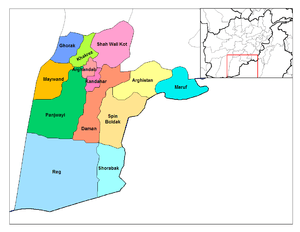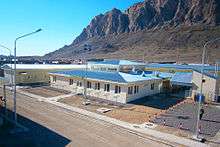Panjwayi District
Panjwayi(Pashto: پنجوايي) (also spelled Panjwaye, Panjwaii, Panjway, Panjwa'i, or Panjwai) is a district in Kandahar Province, Afghanistan. It is widely considered the spiritual home of the Taliban and is located about 35 kilometres (22 mi) west of Kandahar. The district borders Helmand Province to the southwest, Maywand District to the west, Zharay District to the north, Arghandab, Kandahar and Daman districts to the east and Reg District to the south. The population was around 77,200 in 2006, most of which are peasants and poorly educated due to non-availability of schools. The district center is Bazar-e Panjwayi, located in the northern part of the district. The area is irrigated by the Helmand and Arghandab Valley Authority.[1]


Panjwayi is continually the site of fighting and emplacements of improvised explosive devices (IED), with the bulk of Canadian Forces' casualties taken from this district. The 2009 increase in ISAF forces, brought on about by the U.S. surge, increased troop densities in Panjwayi, resulting in a greater ability on behalf of Afghan government and international forces to conduct operations and penetrate into former Taliban strongholds, especially villages in the "Horn of Panjwayi" such as Mushan, Talokan, Sperwan Ghar and Zangabad. These villages are considered the "Birthplace of the Taliban" and were seen as one of the most dangerous regions of Afghanistan for NATO forces. Still, the Taliban maintain a significant psychological and physical presence in the district.
Populated places
War in Afghanistan
2006 Battle of Panjwayi
The district was the scene of the Battle of Panjwayi involving Canadian Forces and Taliban fighters and the theatre of the ISAF Operation Medusa, September 2006. NATO claimed to have killed over 500 Taliban insurgents.[2]
Kandahar massacre
At around 3:00 AM on Sunday, March 11, 2012, a 38-year-old U.S. Army staff sergeant Robert Bales from Joint Base Lewis-McChord (in Washington), is alleged to have gone from house to house in two separate villages in the district (Balandi and Alokzai) and killed 16 Afghan civilians, including 9 children.[3][4]
Other events
On 16 November 2009 Canadian troops captured the Taliban-controlled village of Hajji Baba southwest of Kandahar City.[5]
See also
- Arghandab District
- Zhari District
- Khosrow sofla
- Tarok Kolache
References
- "The Helmand Valley Project in Afghanistan: A.I.D. Evaluation Special Study No. 18" (PDF). C. Clapp-Wicek & E. Baldwin, U.S. Agency for International Development. December 1983.
- "Archived copy". Archived from the original on 2007-09-29. Retrieved 2006-10-07.CS1 maint: archived copy as title (link)
- "U.S. Soldier Opens Fire On Civilians In Afghanistan". The Huffington Post. 11 March 2012.
- "Archived copy". Archived from the original on 2012-03-17. Retrieved 2012-03-17.CS1 maint: archived copy as title (link)
- Fisher, Matthew (November 17, 2009). "Taliban abandon village to Canadian troops". Canwest News Service.